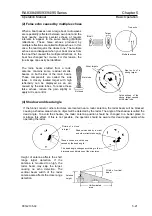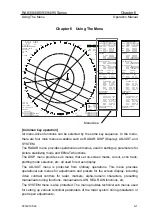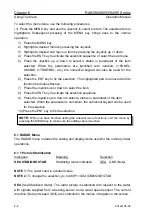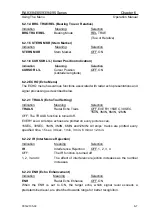
Chapter 5
RA83/84/85/93/94/95 Series
Basic Operation
Operation Manual
Reading the radar images
The following pictures illustrate how the radar picture is constituted from an actual
situation around your own ship.
Picture on the screen
Echo of a small boat
Echoes by windbreak forest
Echo of the sea return
Echo of buoy No.2
Small boat
Buoy No.1
Buoy No.2
Actual view
Windbreak
forest
Sheer cliff
Own ship’s position
Echo of the hill
Echo of a large ship
Large ship
Own ship
The buoy No.1 is not detected because the cape blocks it.
The echo of the large boat is painted similar to its actual profile because of short
distance.
The echo of a small boat is shown as a spot because it has a small echoing area.
The hill located on the starboard (in the bearings of 90 deg to 130 deg) has a deep forest
zone, and its echoing area is large. It is represented as wide spreading echoes on the
screen.
Since the sand beach on the port side is deep, but is not topographic. The echoes are
shown weak.
The windbreak forest produces strong echoes, and it is shown as massive echoes in
high contrast.
The echoes reflected from the sea surface change from time to time, depending on the
wind speed and direction
.
These echoes are shown as a group of spots.
False echoes
The operator should be fully aware of various false echoes caused by the radar
performance, terrain and structures on the land, as mentioned below.
(1) False echo caused by secondary reflection
Real target
An example of false echo
caused by the radar beam
reflected by an aft mast.
Target
Heading Marker
Direct reflection pass
Antenna
Mast
Secondary Reflection pass
False echo
Direct reflection pass
Real target
Secondary
Reflection pass
An example of a temporarily
produced false echo caused by
the radar beam reflected by a
large bridge.
Boat
False echo
False echo
5-20
93142105-02
















































